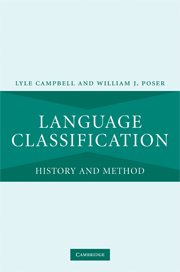Book contents
- Frontmatter
- Contents
- List of figures, tables, and charts
- Acknowledgments
- Preface
- 1 Introduction: how are languages shown to be related to one another?
- 2 The beginning of comparative linguistics
- 3 “Asiatic Jones, Oriental Jones”: Sir William Jones’ role in the raise of comparative linguistics
- 4 Consolidation of comparative linguistics
- 5 How some languages were shown to belong to Indo-European
- 6 Comparative linguistics of other language families and regions
- 7 How to show languages are related: the methods
- 8 The philosophical–psychological– typological–evolutionary approach to language relationships
- 9 Assessment of proposed distant genetic relationships
- 10 Beyond the comparative method?
- 11 Why and how do languages diversify and spread?
- 12 What can we learn about the earliest human language by comparing languages known today?
- 13 Conclusions: anticipating the future
- Appendix: Hypothesized distant genetic relationships
- References
- Index
13 - Conclusions: anticipating the future
Published online by Cambridge University Press: 22 September 2009
- Frontmatter
- Contents
- List of figures, tables, and charts
- Acknowledgments
- Preface
- 1 Introduction: how are languages shown to be related to one another?
- 2 The beginning of comparative linguistics
- 3 “Asiatic Jones, Oriental Jones”: Sir William Jones’ role in the raise of comparative linguistics
- 4 Consolidation of comparative linguistics
- 5 How some languages were shown to belong to Indo-European
- 6 Comparative linguistics of other language families and regions
- 7 How to show languages are related: the methods
- 8 The philosophical–psychological– typological–evolutionary approach to language relationships
- 9 Assessment of proposed distant genetic relationships
- 10 Beyond the comparative method?
- 11 Why and how do languages diversify and spread?
- 12 What can we learn about the earliest human language by comparing languages known today?
- 13 Conclusions: anticipating the future
- Appendix: Hypothesized distant genetic relationships
- References
- Index
Summary
Way back in time all men emerged from a single hole in the earth. There was a mockingbird there at the entrance to the hole. He gave each a name and a language. To one he would say, “You shall be a Hopi and speak that tongue.” To another, “You shall be an Apache and speak that language.” And so it went for all who came from the hole, including the White People. The earth was still covered in darkness in those days so the peoples came together and decided to change things. They made the sun and the moon and placed them in the sky. With light and warmth things got easier for the people so the chiefs of all the races and tribes got together and decided to break up and go to different places.
(www.stavacademy.co.uk/mimir/hopicreation.htm)Past, present, and future
Our intention in this book has been to determine how genealogical relationships among languages can be shown, and thus to contribute to language classification. We have scrutinized carefully the methodology for investigating possible cases of remote linguistic kinship among languages not yet known to be related, and we have evaluated both the methods involved and the evidence presented for a number of the best-known proposals of distant genetic relationship. With respect to the past, we looked carefully at the methods and procedures utilized to establish the better-known language families, learning from both what proved useful and what did not.
- Type
- Chapter
- Information
- Language ClassificationHistory and Method, pp. 394 - 403Publisher: Cambridge University PressPrint publication year: 2008



